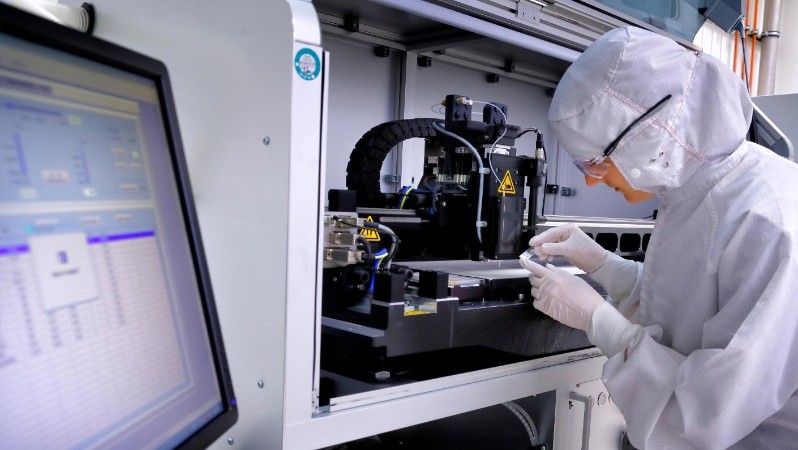
What can this machine do?
Microfluidic chips used for biomedical tests are often pre-loaded with biological material (reagent). In most cases, this reagent is stored in the chip in dried form to prolong the shelf life of the product. How does such a dried drop of reagent end up in the chip? This is done with a low volume liquid dispenser or spotter. A spotter can dispense small drops of liquid with very high accuracy. After a short drying time, the reagent is fixed on the substrate’s surface, awaiting to be resuspended or reabsorbed into the liquid of the assay performed on the chip.
The spotting principle
The head of the spotter contains one or more dispense capillaries that take in a liquid and deposit it highly accurate and in the desired spot size and pattern on the targets surface. Both the sample liquid and target substrates are located within the controlled environment of the machine. The spotting method makes use of acoustic dispensing technology based on piezo-driven pulses. These pulses create a gentle wave inside the capillary that, as a result, ejects a small drop of liquid. This non-contact method enables accurate droplet deposition without harming or changing the biocontents of the sample material.
After spotting, a short drying process follows and the integrated camera checks whether the spotted array falls within the desired tolerances.
Sample material
At Micronit, we predominantly work with biomaterial solutions with a viscosity of up to 20 centipoise (cPs). These can be solutions containing antibodies, proteins, DNA/RNA oligonucleotides, surfactants etc.
We have dispensing experience with the following reagent types:
- Protein solutions: antibodies, antigens, blocking proteins
- Sugars: trehalose, glucose
- Surfactants: Triton X-100, Tween 20, Pluronic F127
- Other solutions: glycerol, nanoparticles
We also have dispensing capability for:
- Nucleic acids: oligonucleotides
- Organic solvents: acetone, DMF, DMSO, ethanol, toluene
Climate control
When dispensing biological samples, it is important to be aware of the fragility of the sample material. A way to preserve the quality of the sample is to keep it under the right climatic conditions. For this, the reagent spotting system is equipped with a climate control system that allows adjusting humidity and temperature. There are chillers under both the sample and the target area that control the temperature of the material between 0-40 degrees.
Furthermore, the drying process can also be regulated by making use of the climate control system. Controlled drying is important in the prevention of uneven concentrations. Adding sugars to the sample material also helps to control the drying speed, and is beneficial for the quality of the sample material.
Droplet size and array options
The dispense capillaries open into a nozzle, which determines the droplet volume. We can offer droplet volumes between 100 and 800 pl, but usually the volumes we are working with are in the range of 360 to 440 pl. The spot accuracy is within 5 µm. The spot-to-spot distance can be anything depending on whether you want the spots to be separated or merge into one another to cover a surface by creating a bigger spot. The size of the spot on the surface is highly dependent on the properties of the reagent and the characteristics of the surface. A good rule of thumb would be that the size of a 400 pl droplet of water creates a spot with a diameter of around 125-150 µm on any given surface.
We also have the capabilities for:
- Spot-in-spot dispensing of different reagents.
- Microarray spotting: a pattern in which each spot has a different composition, for instance different antibodies per spot.
Substrate material
Spotting often takes place on regular substrates such as microtiter plates or microscopic slides. The target area of the spotter is 80 x 36 cm. This accommodates 27 microtiter plates or 140 standard microscope slides. Other targets can also be used, such as biosensors, membranes or microfluidic devices.
The reagent spotting system is equipped with:
- a head camera for target recognition and quality control of the spotted samples
- a cooling unit for the source plate (containing the samples) and the target area
- humidity control within the machine
- a stroboscope camera to image the droplet shape
- incorporated droplet volume detector
Spotting specs summed up:
- Spotting area up to 80 x 36 cm in size
- Standard droplet sizes of 360-440pl
- Additional droplet range extension to 100-800pl
- Spot dimensions dependent on reagent and substrate combination
- Typically: 400pl – Ø 125/150µm | 10nl – Ø ~350µm
- Spotting accuracy < 5µm
- Time to spot 1µl in an array of separate 400pl spots: < 30s
Why are we excited about this machine?
- High precision and consistency - Highly accurate and reproducible droplet dispensing.
- Biocompatibility - Gentle, non-contact technology that isn’t harmful to the biological sample.
- Quality control - Built-in cameras closely monitor drop volume tolerances and pattern deviations.
To us, this spotter is an indispensable part of production facility. We offer spotting as a single service or as part of the full production process of products that we manufacture for customers.
Do you think this machine can be of use in the manufacturing process of your (future) product? Would you like to discuss this with one of our specialists? Contact us straight away!
